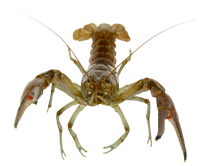Behavioral Neuroscience, lecture on Lateral Giant Neuron control of Crayfish Escape
Escape - Crayfish
X. Parallel Circuits and Non-Giant Neurons
A. Threats that develop gradually
1. do NOT involve MG or LG neurons
2. non-Giant (NG) responses
a. result in adjustable tail flips
i. not stereotypical
b. not single flexions
B. Sensory Interneurons (SI) also have electrical synapses with NG neurons
1. broad range of sensory inputs
2. many SI paths
C. MG/LG - NG circuitry asymmetrical
1. NGs do not innervate MG or LG circuitry
2. MG/LG recruit elements of the NG circuitry
a. via a single pair of SG neurons
D. NG parallel distributed processing network
1. produce very flexible behavior
a. similar to the Mauthner vs M-homolog networks
i. for C-start and escape behavior in fish
2. NG neurons activate a suite of pre-motor interneurons
a. each premotor interneuron has distinct output connections
3. NG-activated Premotor interneurons innnervate FF motor neurons
a. NG à PmI à FF à all abdominal segement muscles
4. NG responses require more time
a. MG/LG < 10 ms >> NG
b. & depends on repetitive firing of premotor interneurons
E. NG circuitry supports a wide range of response patterns
1. exact parameters of response vary
a. as a function of sensory stimulation
